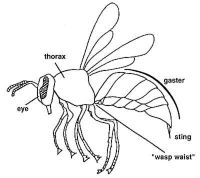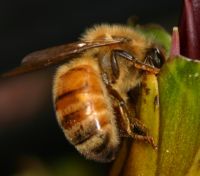Identification
 Order: Hymenoptera
Order: Hymenoptera
Family: Vespidae
Subfamily: Vespinae
Genus: Vespula
Species: V. germanica; V. vulgaris
Wasps, bees and ants (the order "Hymenoptera") differ from other insects by having two pairs of wings that are linked by a row of hooks, and by having a narrow "waist" that joins the abdomen to the thorax. The first segment of the abdomen is fused to the back of the thorax, so the part behind is not the whole abdomen — it is more strictly called the "gaster".
Social wasps can be distinguished from the rest of the Hymenoptera by:
 |
The way they fold their fore- wings back when they are at rest. |
 |
By the pattern of veins on their wings. |
 |
By having kidney-shaped compound eyes. |
 |
Worker wasps and queens look similar, although the queen is much larger. Both have a sting. |
 |
Drones do not have a sting, have more segments on the gaster, and have long curved antennae. |
In New Zealand, German and common wasps are readily identified because there are very few other insect species which look similar. They could be confused with:

Honeybees (Apis mellifera): but honeybees have a different pattern of colouration on the abdomen, which is a dull colour. Honeybees have more hairs on their body, and larger (wider) back legs to help them collect pollen.. Image - Sascha Koch

European Tube wasps (Ancistrocerus gazella); but these are not as large and robust as Vespula, and have a different pattern of colouration on the abdomen.

Asian paper wasps (Polistes chinensis antennalis): which are distinguishable from Vespula by have a different pattern of colouration on the abdomen. Paper wasps do not hold their legs close to their body, so when they fly they have "long dangly legs". Paper wasp nests are found above the ground and are not enclosed, so you can see into the cells (unlike Vespula nests where the layers of cells are enclosed in an envelope).
